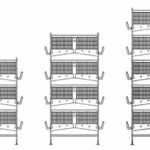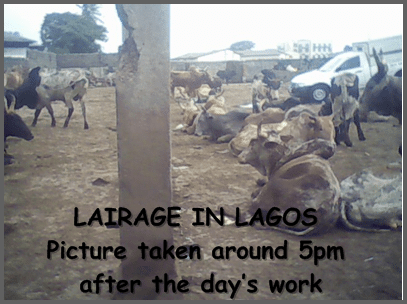Title: Factors Affecting the Establishment and Operations of Slaughterhouses (Abattoirs and Slaughter Slabs) In Oyo State and Lagos State, Nigeria
Project By: OYEDOTUN AHMED AYOADE
Submitted in November 2009 to the Department of Veterinary Public Health and Preventive Medicine, University of Ibadan, in partial fulfillment of the requirement for the award of the degree of Doctor of Veterinary Medicine (D.V.M) of the University of Ibadan, Ibadan, Nigeria.Supervised By:
1. Dr. S.I.B Cadmus
DVM; MVPH; Ph.D. (Ibadan); Department of Veterinary Public Health and Preventive Medicine, University of Ibadan, Ibadan.
2. Dr. Mrs. O.O ISHOLA
DVM; MPVM, (Ib); M.Sc TVE (Berlin); Ph.D. (Ib); Department of Veterinary Public Health and Preventive Medicine; University of Ibadan, Ibadan
INTRODUCTION
Slaughterhouses/abattoirs act as the starting point of the meat industry, where stocks come from farms/market to enter the food chain. They have existed, as long as there have been settlements too large for individuals to rear their own stock for personal consumption.
A slaughterhouse, also called an abattoir (from the French verb abattre, “to strike down”) or freezing works (New Zealand English), is a facility where animals are killed and processed into meat products. The animals most commonly slaughtered for food are cattle (for beef and veal), sheep (for lamb and mutton), pigs (for pork), horses (for horsemeat), and fowl, largely chickens, turkeys, and ducks(Wikipedia, 2009).
Alonge, D. O. in 2005 defined abattoir as a special facility designed and licensed for receiving, holding, slaughtering and inspecting meat animals and meat products before release to the public.
It is notable that in the United States, around ten billion animals are slaughtered every year in 5,700 slaughterhouses and processing plants employing 527,000 workers (Williams, Erin E. and DeMello, Margo, 2007). In 2007, 28.1 billion pounds of beef were consumed in the U.S. alone (Torres Bob. 2007). In Canada, 650 million are killed annually (Global Action Network, 2008.). In the European Union, the annual figure is 300 million cattle, sheep, and pigs, and four billion chickens (Stevenson, Peter. 2001). However in Nigeria, there are no reliable statistics.
In fact, estimates of national livestock populations throughout West Africa have to be treated with considerable reserve. In the case of Nigeria, figures have been cited in many Federal Government documents, often with no indication of the source, or description of the methods of estimation. In some cases, cattle population figures have been derived indirectly from various administrative sources, including jangali tax (a head tax on cattle being moved), vaccination returns, slaughter records, trade movements and exports (Fricke, 1979).
Interpreting such information is highly problematic as unverifiable assumptions must be made about what proportion of a total population is unrepresented. Data collection is rarely standardised or methodical and any given statistic is usually incomplete. Reviews of existing population estimates showed that in some years the discrepancy between the Federal Office of Statistics’ estimate and the FAO estimate was of the order of 100% (RIM, 1992, II: 32). Given these uncertainties, together with the fact that current livestock populations are extrapolated from old data, it is not surprising that such estimates have always been viewed with a degree of scepticism (Colville and Shaw, 1950).
Nevertheless, it is true that meat offers a nutritionally valuable, attractive and widely accepted food, the world demand for which increases daily. Therefore, it is preferable to examine how the demand for meat can be met most efficiently and effectively (D. Lister et al, 1987). Central to this is the role of slaughterhouses. However, slaughtering animals on a large scale poses significant logistical problems and public health concerns.
In most countries, abattoirs (i.e. slaughterhouses) are either privately owned or provided by the local authority. The local authority owns the building and is also responsible for certain essential activities such as sanitation, feeding of animals in the lairage, provision of meat inspection services, etc. In some instances, slaughtering is carried out by a contractor staff and in others by municipal employees, a situation which gives greater control over the quality of employees and their methods. Public abattoirs are open to all who wish to slaughter animals for human food; their revenue is derived from lairage fees, slaughter and refrigeration charges and a variety of other rentals ( Bailliere Tindall, 1981)
My Findings and Recommendations

It is clear from the result of the research that a lot of factors affecting establishment and operations of abattoirs and slaughterhouses in the nation have bearing with the quality of management, expertise of the workforce and government negligence. These are important factors in order to attain better management of resources and hence higher returns on investment, more satisfactory palatability and safe beef for consumers.
Slaughterhouse Management Inadequacies
From the result of the research, most of the slaughterhouses are owned by the government but run by the chairman of the association of butchers. The management therefore has little or no education apart from technical skills. Little wonder, almost all of them normally hire their workers by apprenticeship rather than recruitment from outsiders.
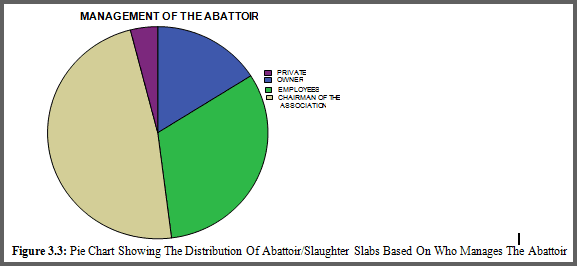 From this study, it is glaring that the greater part of them hold only Secondary school certificate or less and yet, do not pursue further training. This is reflected in the quality of staff working on the abattoir or slaughter slab. FAO in 1998 recognized the lack of adequately trained personnel in the meat and dairy industry as one of the main constraints limiting the improvement of the hygienic and technical quality of meat.
From this study, it is glaring that the greater part of them hold only Secondary school certificate or less and yet, do not pursue further training. This is reflected in the quality of staff working on the abattoir or slaughter slab. FAO in 1998 recognized the lack of adequately trained personnel in the meat and dairy industry as one of the main constraints limiting the improvement of the hygienic and technical quality of meat. 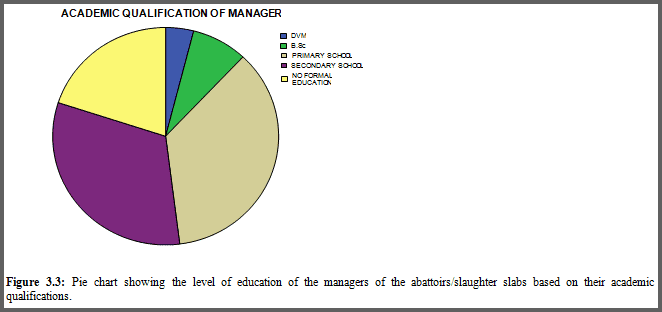
Too Many Small Inefficient Slaughterhouses
Moreover, it is of great concern that most abattoirs/slaughter slabs are small- sized with over 80% slaughtering below 50 cattle per day while a good number barely slaughter up to 10 cattle daily. In other developing countries, particularly Asia, the government together with Food and Agricultural organization (FAO,1988) have team up to set up more efficient modular slaughter facility to harness the potentials of the beef market and its by-products. 
Gunter Heinz in 2008 mentioned that to assist countries and assess the current and future needs of abattoir development in Asia and the Pacific region, the Food and Agriculture Organization of the United Nations (FAO) initiated a technical mission to five selected APHCA-member countries: Indonesia, Nepal, Pakistan, Philippines and Vietnam. The mission’s aim was to gather updated information and create strategies for developing the abattoir sector, with a focus on small- to medium-sized slaughter facilities.
Gross Inadequacy in Slaughter Facilities
Besides, considering that most abattoirs and slaughter slabs have very old structures and hence, the resulting gross inadequacy of facilities (seen in the sparse number of facilities in the result), a consequential negative effect on the health of consumers is a great concern. During his research, Gunter Heinz (in 2008) noticed severe shortcomings in these kinds of abattoirs and slaughter slabs in terms of:
- Animal welfare issues, in particular malpractices in prestunning of slaughter animals.
- Slaughter methods, which in many cases generate high levels of bacterial contamination due to the lack of proper slaughter and by-product handling facilities and careless slaughtering by workers.
- Meat cutting, deboning and transport, which are frequently done in the most unhygienic ways and in inadequate technical and transport facilities.
- Slaughterhouse waste disposal and effluent treatment, which is organized in an unsatisfactory way or not at all, which contributes to the poor quality of slaughterhouse hygiene.
- Meat plant cleaning and sanitation, which is mostly incomplete or impossible to carry out effectively due to the unhygienic structure of premises displaying inadequate building materials, floor and wall cracks and damages as well as heavy corrosion through the unavailability of anticorrosive materials.
- Meat inspection and sanitary control, which is deficient in many slaughterhouses.
Disregard for Palatability
Now, looking at the age of cattle at slaughter, 88% of investigated abattoirs and slaughter slabs blindly slaughter cattle above 2 years old (older than 730 days) which are inadequate considering the palatability of the beef produced from them. Field et al (1971), in his journal opined that beef tenderness decreased with the age of the cattle, thereby compromising the palatability of the meat. His result suggests that bulls sold for block beef should be slaughtered less than 400 days of age. This assertion was corroborated by Purchas who mentioned in his result that beef tenderness is determined more by the age at slaughter than by early growth rates.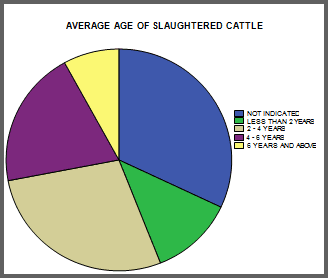
This is important because consumers consider three characteristics—flavor, juiciness and tenderness—as they evaluate “palatability” and(or) satisfaction received by eating beef(M.K Patterson, 1998). Of these three characteristics, the 1983 National Consumer Retail Beef Study identified tenderness as the most important factor in determining eating satisfaction of beef. The 1990 National Beef Market Basket Survey also identified tenderness as being the single most important factor determining consumers’ perception of taste.
My Recommendations
- The Ministry of Agriculture and Food should develop standardized training programs for all personnel at abattoirs on humane animal handling, slaughter and dressing.
- The Ministry of Agriculture and Food should implement a policy of continuing education and training for its meat inspectors and veterinarians. Also they should implement a plan for the initial and continuing education and training of appointed veterinarians.
- The Ministry of Agriculture and Food should increase the number of veterinarians allocated for food inspection in each slaughter slab and abattoir.
- The Ministry of Agriculture should be urgently upgrade slaughter slabs to modular slaughterhouses with the more hygienic and easier to supervise line-slaughter system.
- The regulations relating to ante and post mortem inspection and specified risk materials removal should be closely monitored and strictly enforced.
- The abattoir management system should include a waste management plan designed for abattoir operation
- The government should enforce existing laws related to abattoir and new ones.
Contact – oyedotun.ayoade [at] gmail.com
————————————————————————————————————————-

